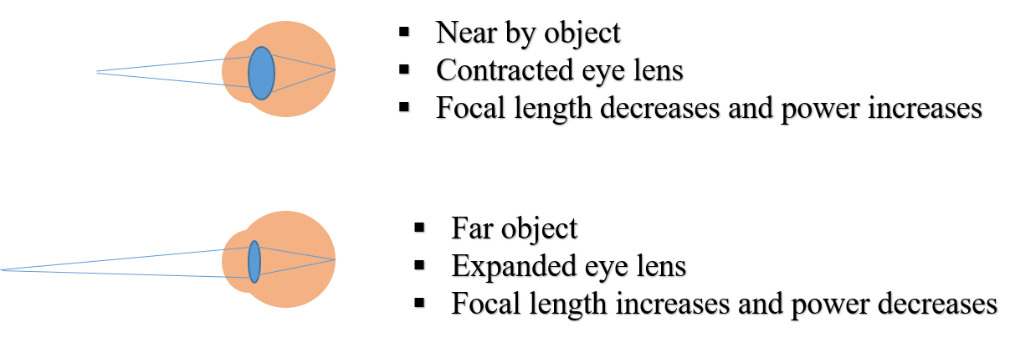
What do you mean by power of accommodation of the eye?
Answer
594.3k+ views
- Hint: There is a lens in our eye. You can directly link the definition of power of a lens in this case.
Complete step-by-step solution -
If we go by simple definition then we can say that accommodation of the eye is the ability of some muscles (ciliary muscles) to change the focal length of the eye lens to focus near or distant objects.
Human eye is multifunctional. For projecting a clear image of an object, the eye performs many functions. Adjusting the focal length of an eye lens is one of the many processes. Depending on the position of an object that is either near or far, the ciliary muscle contract or expands to change the focal length such that a clear image can be formed on the retina.
For visual aid, two images are shown below:

The ability of the eye lens to adjust its focal length, so as to clearly focus rays coming from distant as well a near object on the retina, is called the power of accommodation of the eye.
Additional Information: The eye has many parts that must work together to produce clear vision:
The sclera, or white part of the eye, protects the eyeball.
The pupil, or black dot at the centre of the eye, is an opening through which light can enter the eye.
The iris, or coloured part of the eye, surrounds the pupil. It controls how much light enters the eye by changing the size of the pupil.
The cornea, a clear window at the front of the eye, covers the iris and the pupil.
A clear lens, located behind the pupil, acts like a camera lens by focusing light onto the retina at the back of the eye.
The retina is a light-sensitive inner lining at the back of the eye. Ten different layers of cells work together in the retina to detect light and turn it into electrical impulses.
Note: The power of accommodation is related to the lens in the eye not related to the power of ciliary muscles.
Complete step-by-step solution -
If we go by simple definition then we can say that accommodation of the eye is the ability of some muscles (ciliary muscles) to change the focal length of the eye lens to focus near or distant objects.
Human eye is multifunctional. For projecting a clear image of an object, the eye performs many functions. Adjusting the focal length of an eye lens is one of the many processes. Depending on the position of an object that is either near or far, the ciliary muscle contract or expands to change the focal length such that a clear image can be formed on the retina.
For visual aid, two images are shown below:

The ability of the eye lens to adjust its focal length, so as to clearly focus rays coming from distant as well a near object on the retina, is called the power of accommodation of the eye.
Additional Information: The eye has many parts that must work together to produce clear vision:
The sclera, or white part of the eye, protects the eyeball.
The pupil, or black dot at the centre of the eye, is an opening through which light can enter the eye.
The iris, or coloured part of the eye, surrounds the pupil. It controls how much light enters the eye by changing the size of the pupil.
The cornea, a clear window at the front of the eye, covers the iris and the pupil.
A clear lens, located behind the pupil, acts like a camera lens by focusing light onto the retina at the back of the eye.
The retina is a light-sensitive inner lining at the back of the eye. Ten different layers of cells work together in the retina to detect light and turn it into electrical impulses.
Note: The power of accommodation is related to the lens in the eye not related to the power of ciliary muscles.
Recently Updated Pages
Master Class 12 Business Studies: Engaging Questions & Answers for Success

Master Class 12 Economics: Engaging Questions & Answers for Success

Master Class 12 English: Engaging Questions & Answers for Success

Master Class 12 Maths: Engaging Questions & Answers for Success

Master Class 12 Social Science: Engaging Questions & Answers for Success

Master Class 12 Chemistry: Engaging Questions & Answers for Success

Trending doubts
What are the major means of transport Explain each class 12 social science CBSE

Which are the Top 10 Largest Countries of the World?

Draw a labelled sketch of the human eye class 12 physics CBSE

How much time does it take to bleed after eating p class 12 biology CBSE

Explain sex determination in humans with line diag class 12 biology CBSE

Differentiate between homogeneous and heterogeneous class 12 chemistry CBSE




